If you keep chickens, you've likely read that adding apple cider vinegar (ACV) with "the mother" to their drinking water is good for them, but don't believe everything you read.
I have read a few studies that left me with more questions than answers about the use of ACV in chickens' drinking water, so I brought them to Dr Mike Petrik, DVM, MSc, aka: the Chicken Vet, for his expert opinion.
"I have never found any study that showed any value to apple cider vinegar specifically, and several studies (the Journal of Applied Poultry Science in 2011, and Asian Australasian Journal of Animal Science), showed that broiler (meat) chickens grew slower when fed 0.5% apple cider vinegar or formic acid vs. pure water. Acidified water also [negatively] affects laying hens by making the calcium in her feed a little less digestible . Professional farmers regularly add baking soda to their feed when heat stress is expected….this maintains egg shell quality when hens' feed consumption drops due to the heat."
Dr. Mike Petrik, DVM, MSc,
"Unfortunately, the broad claims for the health benefits of vinegar that you see are grossly exaggerated. There are very few scientific studies looking into the effects of dietary vinegar in humans or chickens, and most of the time, the results of one study may be refuted by another. What the research suggests is that more research needs to be done. There are many people who feel that vinegar helps with many things; there are also many people who believe that a placebo will stop pain. That is why good research studies are always designed to take the placebo effect into consideration. In most cases using some vinegar is unlikely to do harm, as long as you don't get carried away with it. Just be realistic in your expectations and you'll be in good shape."
Dr. Mikelle Roeder,
Research scientist at Purina Animal Nutrition
RAW APPLE CIDER VINEGAR WITH THE MOTHER:
GREAT FOR SALAD DRESSING!
Raw, unpasteurized vinegar contains live bacteria and yeast known as the mother or SCOBY, an abbreviation for symbiotic culture of bacteria and yeast. The mother converts alcohol to acetic acid (aka: vinegar) and its beneficial bacteria remain in the vinegar as a microbe. Pasteurizing vinegar kills these living components.
THE BASIC ACV FORMULA:
ACV in its most basic form is made by combining:
3 parts Vinegar Stock (attained through yeast fermentation of apples into alcohol aka: hard cider)
plus
1 part Vinegar Culture (attained through converting alcohol into acetic acid by use of acidbactar bacteria/a mother/a SCOBY)
3 RECIPES for APPLE CIDER VINEGAR
RECIPE #1- Hard Cider + the mother
I purchased 24 ounces of hard cider locally for $3.34 and ordered 8 ounces of Mother of cider vinegar from Leener's for $11.95
Place in a warm, dark(ish) place and wait for the mother to convert the alcohol to vinegar. The vinegar smell is unmistakable when it is ready. It can take as few as several weeks or as many as several months for the conversion to take place. Temperatures between 80-90° F will allow for fastest conversion. Avoid fluctuations in temperature.
In four weeks, this mixture turned the hard cider to vinegar. The mother can be seen below as a porous-looking sponge at the bottom of the jar. The formation of this opaque, leathery-feeling mother is evidence that the alcohol has been converted to vinegar. If left to ferment further, the mother will continue to thicken. The mother requires access to oxygen to perform its conversion and since mine sank, I made a 'raft' for it of two toothpicks, bound together.
I made a raft for the mother out of toothpicks
To begin a new batch of vinegar, add 24 ounces of hard cider to some of the vinegar you just made. Share the extra mothers with a friend or start another, new jar of vinegar with it.
RECIPE #2- Apples + water + the mother
I am not a vinegar-making expert, but I did consult with one regarding questions I had about vinegar making, particularly as to the method utilizing fresh apples. Jim Leverentz of Leeners indicated that it is best to ferment fresh pressed or juiced apples with wine yeast, then add the mother to make vinegar. But, I had read about a simpler take on this method and wanted to give it a shot. By some stroke of luck and with consistently high heat for several weeks this summer, my garage provided the perfect environment for making ACV from fresh apples. While this is not the ideal way to begin a batch of vinegar, it is the simplest and most cost effective. I was fortunate that someone locally shared a mother of theirs with me to begin this batch of ACV.
The mother isn't pretty, but it's pretty amazing!
ACV RECIPE #3- Unpasteurized apple juice + ACV containing the mother (eg Braggs)
This method did not work well for me, likely because it was kept in the basement, where the temperatures were much too low to convert the apple juice into alcohol, but it should work under proper conditions.
When the liquid smells like vinegar and a visible film has formed in the jar, (the new mother) pour off 2/3 of the vinegar into a sterile bottle to use. Reserve both mothers in a small jar of vinegar and either share with a friend or make more vinegar. It is not necessary for a visible mother to be present to begin a new batch, repeating the process as before but using your own, homemade vinegar this time!
Order your copy of my bestselling book,
The Chicken Chick's Guide to Backyard Chickens!
Kathy Shea Mormino
Affectionately known internationally as The Chicken Chick®, Kathy Shea Mormino shares a fun-loving, informative style to raising backyard chickens. …Read on


shop my SPONSORS
If you keep chickens, you've likely read that adding apple cider vinegar (ACV) with "the mother" to their drinking water is good for them, but don't believe everything you read.
I have read a few studies that left me with more questions than answers about the use of ACV in chickens' drinking water, so I brought them to Dr Mike Petrik, DVM, MSc, aka: the Chicken Vet, for his expert opinion.
"I have never found any study that showed any value to apple cider vinegar specifically, and several studies (the Journal of Applied Poultry Science in 2011, and Asian Australasian Journal of Animal Science), showed that broiler (meat) chickens grew slower when fed 0.5% apple cider vinegar or formic acid vs. pure water. Acidified water also [negatively] affects laying hens by making the calcium in her feed a little less digestible . Professional farmers regularly add baking soda to their feed when heat stress is expected….this maintains egg shell quality when hens' feed consumption drops due to the heat."
Dr. Mike Petrik, DVM, MSc,
"Unfortunately, the broad claims for the health benefits of vinegar that you see are grossly exaggerated. There are very few scientific studies looking into the effects of dietary vinegar in humans or chickens, and most of the time, the results of one study may be refuted by another. What the research suggests is that more research needs to be done. There are many people who feel that vinegar helps with many things; there are also many people who believe that a placebo will stop pain. That is why good research studies are always designed to take the placebo effect into consideration. In most cases using some vinegar is unlikely to do harm, as long as you don't get carried away with it. Just be realistic in your expectations and you'll be in good shape."
Dr. Mikelle Roeder,
Research scientist at Purina Animal Nutrition
RAW APPLE CIDER VINEGAR WITH THE MOTHER:
GREAT FOR SALAD DRESSING!
Raw, unpasteurized vinegar contains live bacteria and yeast known as the mother or SCOBY, an abbreviation for symbiotic culture of bacteria and yeast. The mother converts alcohol to acetic acid (aka: vinegar) and its beneficial bacteria remain in the vinegar as a microbe. Pasteurizing vinegar kills these living components.
THE BASIC ACV FORMULA:
ACV in its most basic form is made by combining:
3 parts Vinegar Stock (attained through yeast fermentation of apples into alcohol aka: hard cider)
plus
1 part Vinegar Culture (attained through converting alcohol into acetic acid by use of acidbactar bacteria/a mother/a SCOBY)
3 RECIPES for APPLE CIDER VINEGAR
RECIPE #1- Hard Cider + the mother
I purchased 24 ounces of hard cider locally for $3.34 and ordered 8 ounces of Mother of cider vinegar from Leener's for $11.95
Place in a warm, dark(ish) place and wait for the mother to convert the alcohol to vinegar. The vinegar smell is unmistakable when it is ready. It can take as few as several weeks or as many as several months for the conversion to take place. Temperatures between 80-90° F will allow for fastest conversion. Avoid fluctuations in temperature.
In four weeks, this mixture turned the hard cider to vinegar. The mother can be seen below as a porous-looking sponge at the bottom of the jar. The formation of this opaque, leathery-feeling mother is evidence that the alcohol has been converted to vinegar. If left to ferment further, the mother will continue to thicken. The mother requires access to oxygen to perform its conversion and since mine sank, I made a 'raft' for it of two toothpicks, bound together.
I made a raft for the mother out of toothpicks
To begin a new batch of vinegar, add 24 ounces of hard cider to some of the vinegar you just made. Share the extra mothers with a friend or start another, new jar of vinegar with it.
RECIPE #2- Apples + water + the mother
I am not a vinegar-making expert, but I did consult with one regarding questions I had about vinegar making, particularly as to the method utilizing fresh apples. Jim Leverentz of Leeners indicated that it is best to ferment fresh pressed or juiced apples with wine yeast, then add the mother to make vinegar. But, I had read about a simpler take on this method and wanted to give it a shot. By some stroke of luck and with consistently high heat for several weeks this summer, my garage provided the perfect environment for making ACV from fresh apples. While this is not the ideal way to begin a batch of vinegar, it is the simplest and most cost effective. I was fortunate that someone locally shared a mother of theirs with me to begin this batch of ACV.
The mother isn't pretty, but it's pretty amazing!
ACV RECIPE #3- Unpasteurized apple juice + ACV containing the mother (eg Braggs)
This method did not work well for me, likely because it was kept in the basement, where the temperatures were much too low to convert the apple juice into alcohol, but it should work under proper conditions.
When the liquid smells like vinegar and a visible film has formed in the jar, (the new mother) pour off 2/3 of the vinegar into a sterile bottle to use. Reserve both mothers in a small jar of vinegar and either share with a friend or make more vinegar. It is not necessary for a visible mother to be present to begin a new batch, repeating the process as before but using your own, homemade vinegar this time!
Order your copy of my bestselling book,



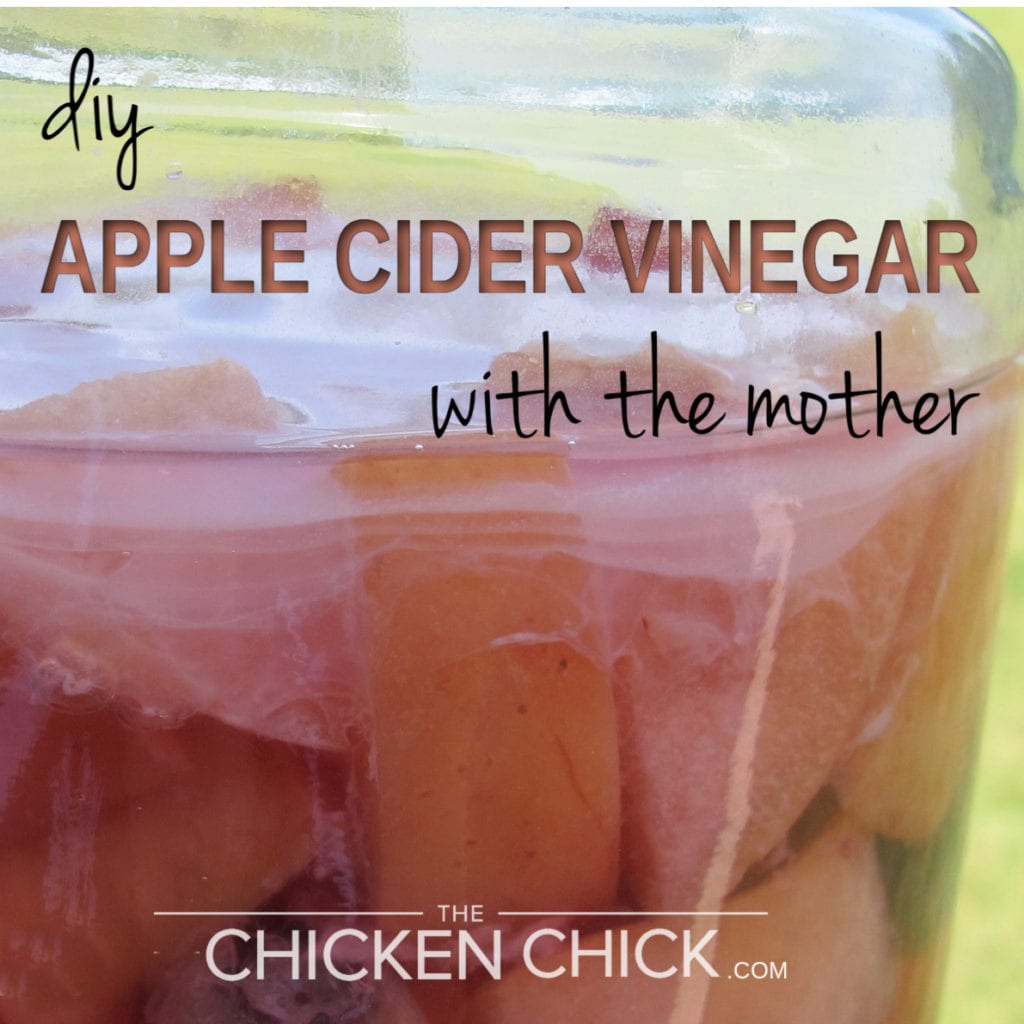
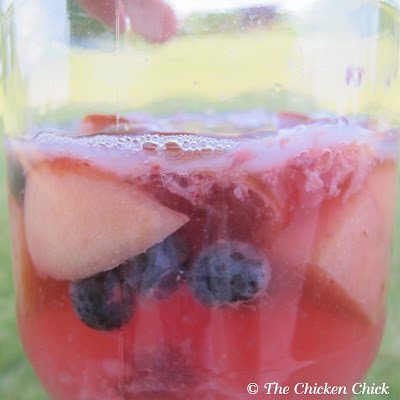

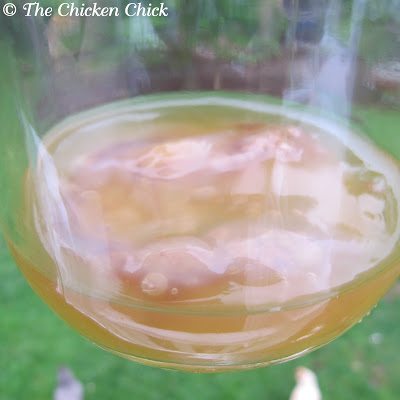
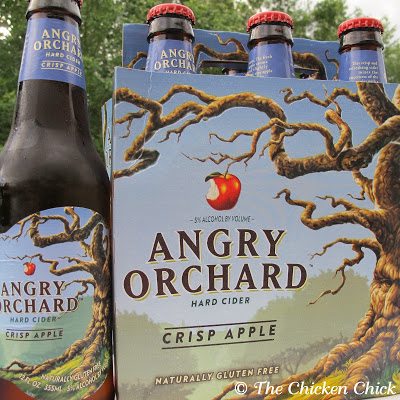
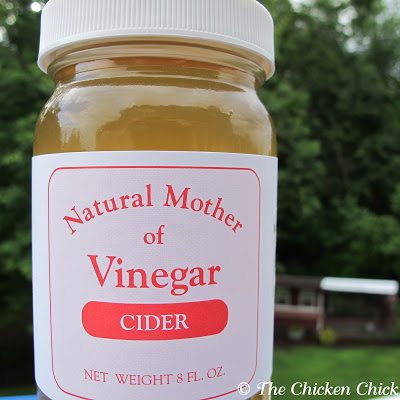
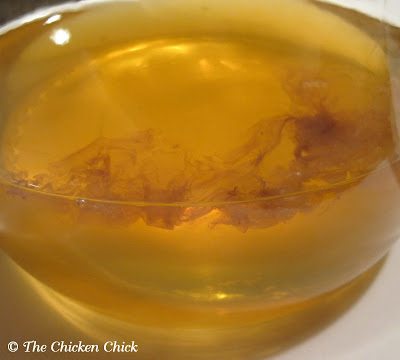
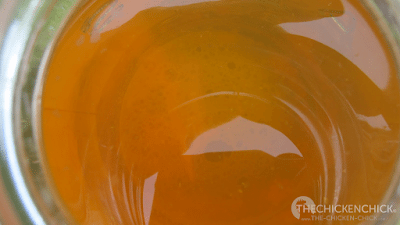
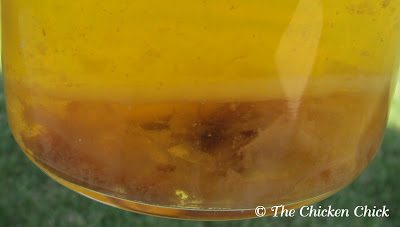
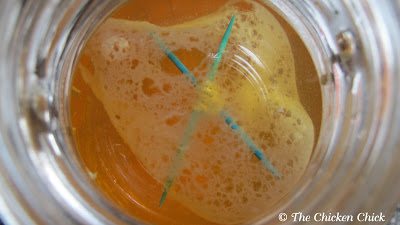
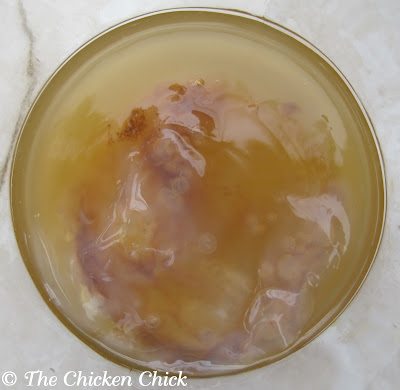
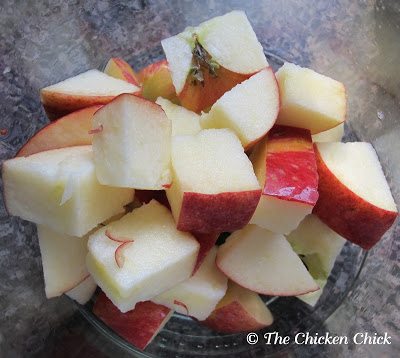
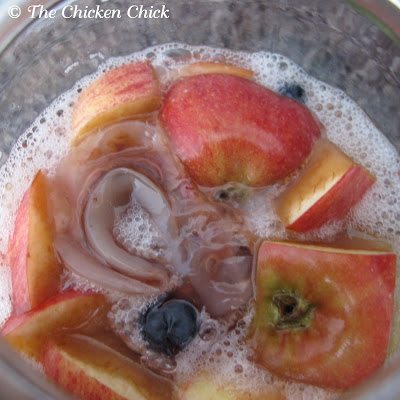
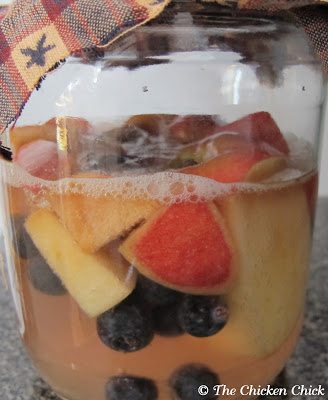
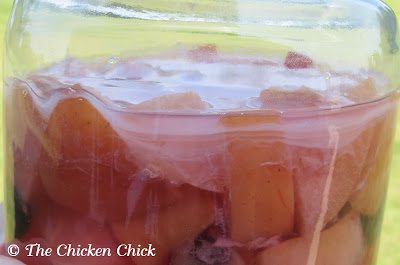
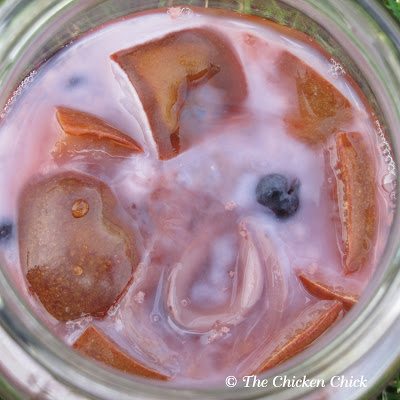
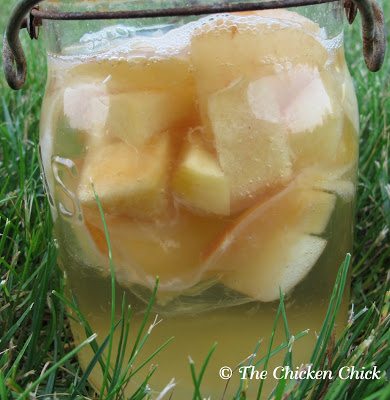
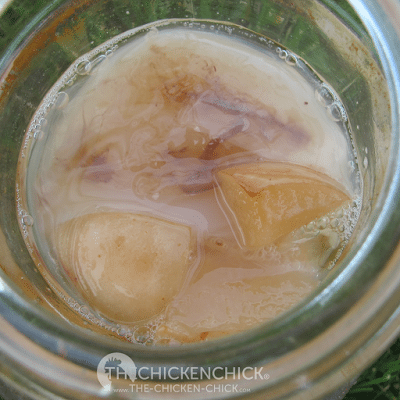
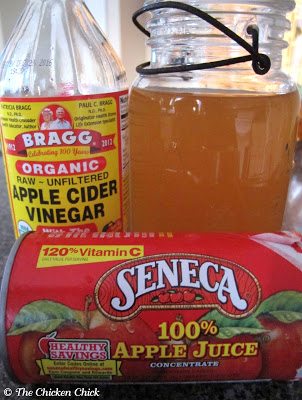
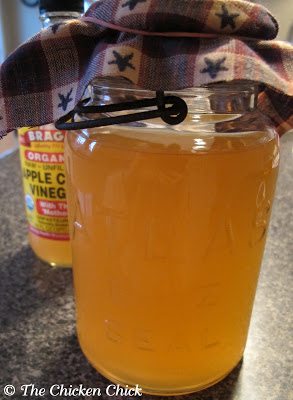
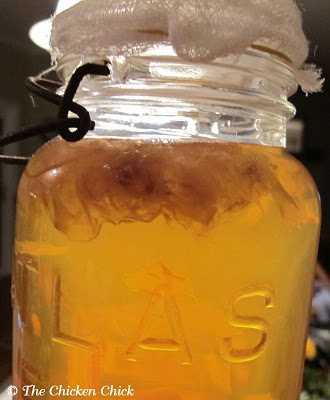























I make Kombucha, using the same exact method, only with a sweet green tea base. If left on the kitchen counter for a while, it easily turns to a probiotic rich vinegar. Is there any reason I couldn't give that to my chickens, in their water?
Only one mother is needed.
Quick question on quantities. I bought one gallon jars but with only 24 oz of hard cider and the mother, it barely comes up over the spigot, lots of empty jar left. What would happen if I increased the amount of hard cider, would I need two mothers? I guess the question is how can I increase the quantity I make. Also how much water do you add with the fresh apple version, I think the ratios are confusing me. Thanks, my 10 girls owe a lot to you, as do I.
I do not recommend even trying it. Alcohol and chickens should not mix.
I have a question for you. I would love to know what you think about this. I have a bunch of watermelon wine that is not very appealing to the palate. I hate to waste it. I am thinking of buying some of the Bragg's (because that is what is easily available to me) and mixing it with the "funky socks" tasting watermelon wine and seeing if it would turn into vinegar so we can use it for the chickens. Do you think that would work? I wonder what ratio of the mother containing vinegar I would need to convert… Read more »